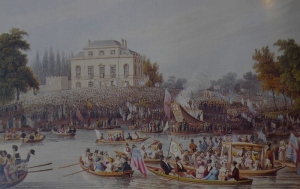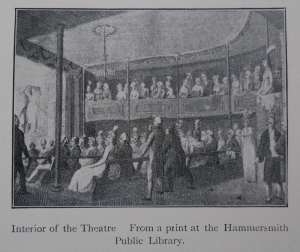Queen Caroline, the wife of King George IV, lived at Brandenburgh House in Fulham, “a splendid seventeenth century mansion overlooking the Thames”, for the last two years of her life. She died there in August 1821.
Brandenburgh House had been built by Sir Nicholas Crispe in the reign of Charles I. It was unusual at the time as it was built of brick. As Fèret remarked in his Fulham Old and New,
“the impetus that he gave to this industry must have been great as, down almost to our own age, brickmaking was a trade very extensively practised in Fulham”.
The house was later bought by Prince Rupert for his mistress and in 1749 by George Dodington, the future Lord Melcombe. He named it La Trappe after the monastery in France, spent a fortune on it, repairing and modernising it throughout and building a magnificent gallery:
In 1792 it was bought by the Margrave of Brandenburgh who had married Lady Craven and it was then that it became known as Brandenburgh House. They also made extensive improvements and erected a little pseudo-gothic theatre close to the water. The Margravine was an amateur actress and wrote plays for her friends that were performed in the theatre. There is a collection of press cuttings in the Hammersmith & Fulham Archives describing some of the entertainments given at Brandenburgh House at that time. The Margrave died in 1806 and his widow made it her home until she retired to Naples in 1819.
It was the Margravine’s son, Mr Keppel Craven, who persuaded her to offer Queen Caroline the use of Brandenburgh House once it was realised that the government had no intention of providing her with a royal residence.
Caroline of Brunswick had become engaged to the future George IV in 1794. George was already secretly married to Maria Fitzherbert, though it was not legal as he did not have the permission of the King to marry, necessary under the Royal Marriages Act 1772. George III refused to give financial help to his debt-ridden, wayward heir unless he married. Caroline of Brunswick was considered a suitable match and she and George were engaged despite having never met.
The marriage between Caroline and George was a disaster from the start. Both parties were immediately repelled by the other. George, upon seeing Caroline for the first time, called for a glass of brandy and was extremely drunk during the wedding ceremony. Nevertheless Caroline gave birth to a girl, Princess Charlotte, on 7 January 1796, nine months after the wedding, although by April 1796 the couple had formally separated. Caroline became increasingly isolated socially and, unhappy at her situation and treatment in Britain, eventually left for mainland Europe in 1814.
In 1820, George became King and Caroline returned to Britain to assert her position as Queen. George hated her and vowed she would never be the Queen. He attempted to strip her of the title of Queen and to divorce her by introducing the Pains and Penalties Bill to Parliament. It was claimed that Caroline had committed adultery and various witnesses were called during the reading of the bill, which was effectively a public trial of the Queen. To her friends, Caroline joked that she had indeed committed adultery once—with the husband of Mrs. Fitzherbert, the King.
Cruel cartons were published at the time such as this one below described as “An intoxicating evening at Brandenburg House where the Queen dreams of coronation”:
The trial caused a sensation but George was deeply unpopular – he was seen as an incompetent drunk – whereas Caroline was viewed as the wronged wife and was so popular with the masses that the Bill was withdrawn by the government.
During the trial, Caroline had brought her household to Brandenburgh House. It was hoped that she would find peace and quiet in the lovely house overlooking the Thames. Strong public feeling had been aroused by the King’s refusal to allow her to be crowned and once it was known that she could be reached by boat, she was inundated by deputations and noisy river parties.

“A regatta before Brandenburg House to accompany the Watermen of England’s arrival with their address to the Queen”
In July 1821, Queen Caroline was barred from the coronation on the orders of the King. She soon after fell ill and told Henry Brougham “I am going to die … but it does not signify”. She died at Brandenburg House three weeks later on 7 August 1821.
Queen Caroline was the last and most illustrious resident of Brandenburgh House. In 1822 the property was sold and the house demolished. On the site was built the first and largest of the industrial development schemes that were soon to stretch right along the river in Fulham. The Haig Distillery was erected in 1857 on part of the former grounds, and in 1872 Alexander Manbre built his sugar refinery on the remainder of the site. Nowadays Fulham Reach, a large development of apartments by the St George’s Group, occupies the river area.
The Fulham & Hammersmith Archives contain prints and cuttings of Brandenburg House and on the shelves in the Local Studies Library at Hammersmith Library you will find the old historic history books of Fulham and biographies of Queen Caroline.
[Fiona Fowler, volunteer]









You must be logged in to post a comment.